Oldsmobile Railroad Inspection Car
The January 1999 issue of the Newsletter included a recent reprint of a catalog showing all the different models of the Railroad Inspection car. The little eight page brochure was purchased at Hershey a few years ago.
As far as we know, there are no surviving vehicles of this type. Likely Olds built less than 100 over the 1902-07 period and because they were for commercial applications, there were no garages or barns for storage once the utilitarian value was gone. Likely nobody took them home except maybe for parts.
There is one letter, reproduced in this brochure, which is dated August 31, 1904. This would date the document sometime in the last half of 1904.
The eight page Inspection Railroad Inspection Car brouchure is reproduced and can be accessed by
clicking/tapping here. (The PDF file will open in a new tab/window.)
The article below was submitted by Rick Kaiser, Archivist at the R. E. Olds Transportation Musesum in Lansing, Michigan, USA.
Oldsmobile Railroad Inspection Car
By Rick Kaiser
With production limited to only 127 total units, the Olds Rail Road Inspection Car may in fact be the most rare of all production cars in the history of Olds Motor Works — Oldsmobile — GM. Built by Olds Motor Works from 1903 to 1905 it was sold exclusively by the Railway Appliance Company of New York and Chicago. Both the Model No. 1 and the Model No. 2 were built using the basic Curved Dash Olds platform.
Using a 4½ HP motor, the Model 1 was able to transport up to four passengers, who were seated in a back-to-back arrangement. While its frame was of tubular steel it had oak sills. Its 20-inch diameter wheels were 4½ inches wide with one-inch flange and made of pressed steel. Stopping the car was accomplished by a braking system that applied brakes to both the driving sprocket and the rear wheels. The car used only one forward and one reverse gear. The Model 1 was the smaller of the two with the Model 2 being redesigned as "… the result of a study of the varying demands and conditions on the part of our patrons …". Early advertisements fixed the price at $450.
At 1200 lbs the Model 2 had an overall length of 111 inches on a 64-inch wheelbase. With a overall width of 65 inches the car was built for the standard 56½ inch wide gauge but could be made to fit any gauge down to a 42-inch minimum. The Model 2's frame was now of pressed steel with reinforced cross members. Oak handles were added to both ends of the frame to help in placing and removing the car from the rail line. Seating was expanded to 6 via a removable, side seating, 48-inch long tonneau. With the tonneau removed an optional Tool Deck could be installed. A 7 HP motor now delivered power and while the motor was the same as the one used in the standard Olds Runabout, it was geared at a higher ratio. Additionally the transmission was expanded to one reverse and two forward gears. Top speed was about 30 MPH. Both models carried enough fuel and water for a 100-mile trip with larger capacity tanks optional on the Model 2.
Interestingly, listed along with the various options was the promise that a trainer would be sent out to instruct in the operation of the car wherever possible. Also included "with each car (was) a complete set of tools for making ordinary adjustments." While an air compressor and whistle replaced the automobile horn, no lamps — headlights — or any replacement for them were included.
One piece of advertising for the Inspection Cars stated: "By virtue of the economy, both money and time, the Oldsmobile Inspection Car has won its 'right of way' and has already taken its place in the regular equipment of almost every modern railroad." If that statement is true or not is unknown, however, it is known that the car was used on the Boston and Albany road. Also several pieces of correspondences with regards to the inspection car were exchanged between Olds Motor Works, Railway Appliance Co. and Sierra Railroad. A letter dated February 3, 1904 from Olds Motor Works to the railroad stated that; "… one Oldsmobile Railroad Inspection Car will be shipped to Jamestown for account your Company the latter part of this week or early next." In late May the same year, Sierra Railroad revealed it intention to order ten more of the cars.
While no specific evidence of purchase has been discovered, the Michigan Central Railroad expressed enthusiastic support of the Oldsmobile Railroad Car. In a letter from their Chief Engineer's Office to Mr. C. F. Quincy, President Railway Appliance Company, W. S. Kinnear writes, "I have made two or three trips with a car furnished me by the Olds Motor Works … I am more then pleased with the performance, and am thoroughly satisfied the car as now manufactured, with a few minor improvements for the convenience of occupants, will prove a very great success for close inspection of track."
Since this article was first published in the Fall 2007 issue of the R. E. Olds Transportation Museum's
Spirit newsletter, new information has been located.
Catalog No. 116 for the Railway Appliance Company clearly states that only they sold the Oldsmobile Railroad Inspection Car. However original Head Office Orders from the Detroit office of Olds Motor Works show that at least through the end of June 1904 some orders were handle directly by that office.
Those same Head Office Orders show that the Tonopak R. R. Co. of Sodaville Mo., the Utah Auto Company of Salt Lake City, Jas. B. Weed & Co of Slate Run Pa. and R. N. Halstead placed orders for complete cars. On May 25th 1904 Head Office Order Number 186 was issued for the purchase of one RR Inspection Car for export to the E. S. Cobre Mines in Santiago de Cuba. In addition to the orders for complete car both the Sierra and Virginia & Southwestern railroads placed orders for "… set{s} of wheels and axles for RR Inspection Car. Wheels are to have wide traction face. The Experimental Dept. is to make the above."
It can be assumed that, since these orders were placed in the first half of 1904 and that most of the vehicles were ordered as 36" gauge without any model notations, these inspection cars were all Model 1 versions. If this is true then it would appear the Model 1 was narrower and therefore able to accommodate a narrower gauge then the Model 2's 42-inch minimum. And due to the fact that these Head Office Orders were being sent to the Lansing plant one might conclude that, at the time, all inspection cars were built at that plant.
Records indicate that only three RR Inspection cars were built in 1903. One of those three was displayed at the "… Automobile Show at Madison Square Garden." The show took place on or shortly after January 17, 1904. Included in the display were a Series N, T and C machine along with a Special Finish Delivery Wagon. In April 1904, a RR Inspection car was rushed through production and shipped to the Oldsmobile exhibit at the Worlds Fair.
It should also be noted that the Model 1 featured front wheel drive — 60 plus years before the Olds Toroado!
[Thanks to Brian R. Curnow and the Sierra Railway for providing article information.]
The article below is from the Automobile Review and was orginally published in the January 1999 CDO Newsletter.
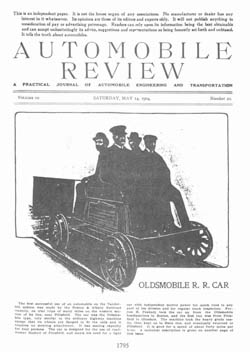
The following information in no special order, was provided by
Don Ball from various internet sources.
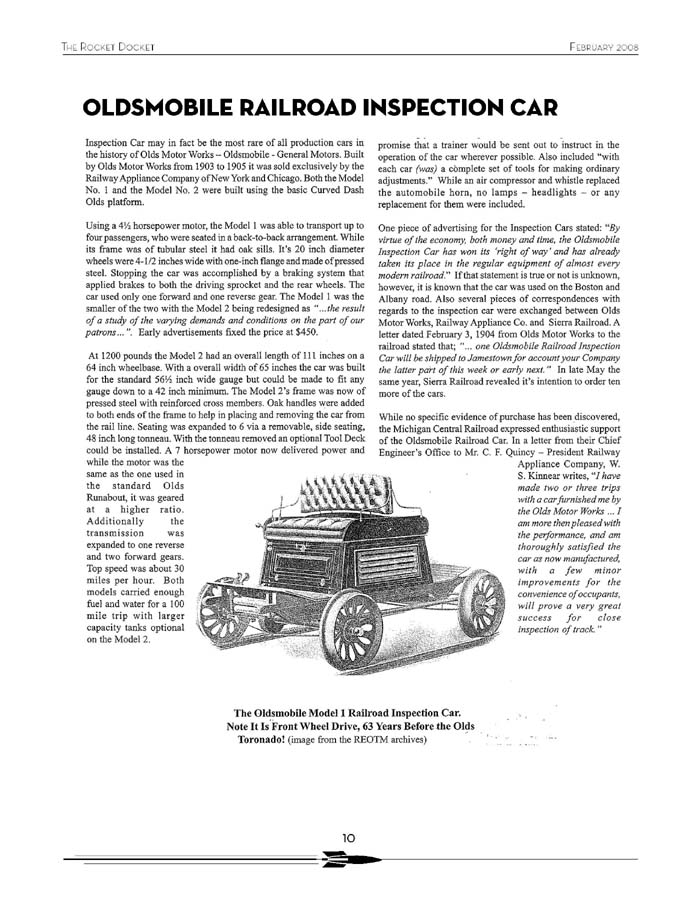
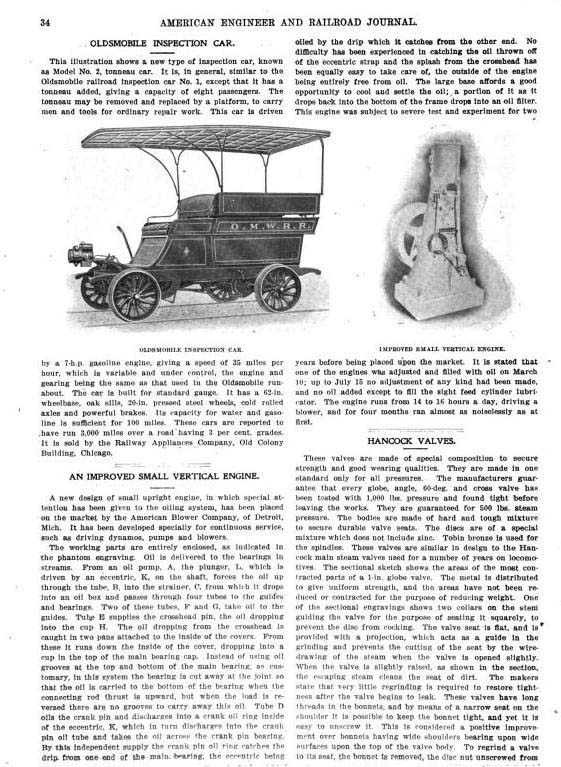
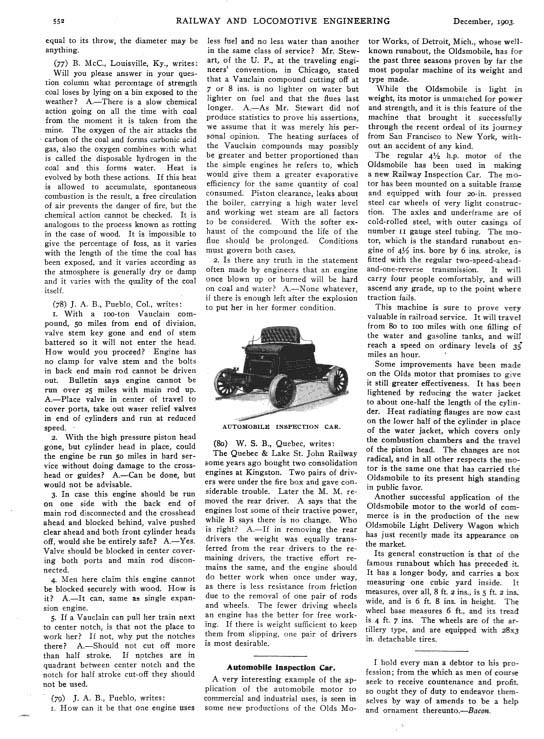
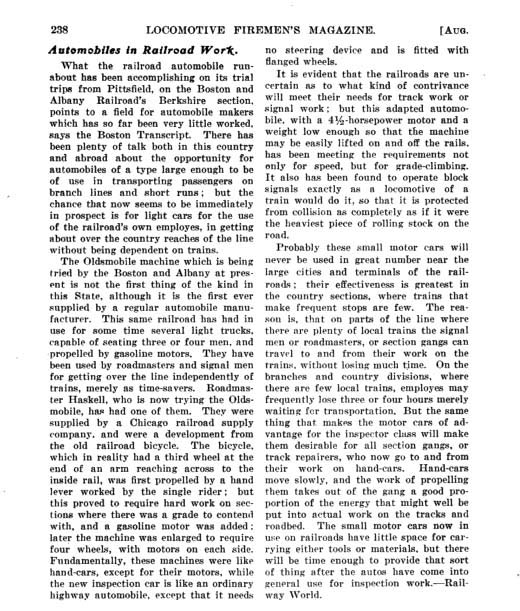

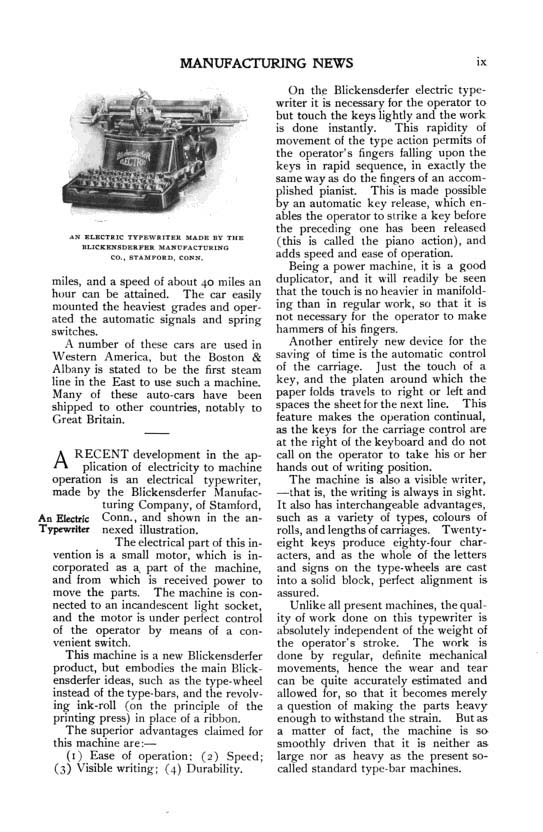

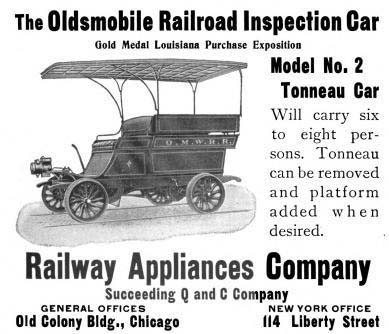

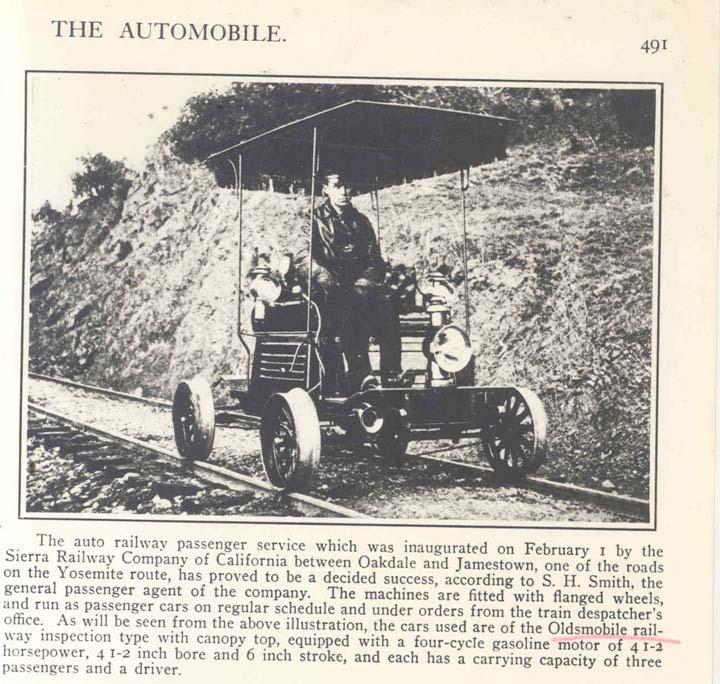
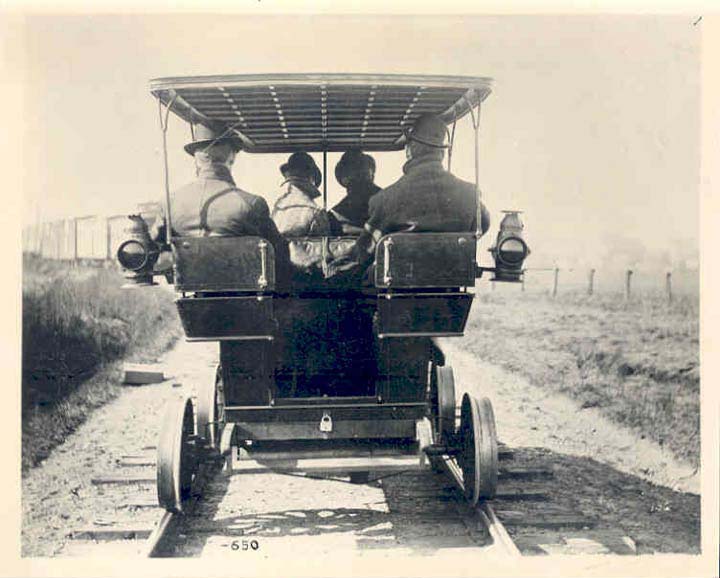
Last updated 4 Nov 2009











